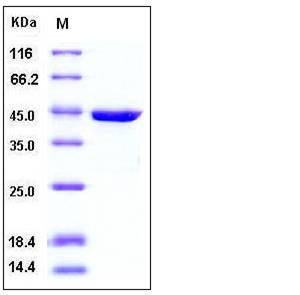Human RAC1 / MIG5 Protein (GST Tag)
MIG5,p21-Rac1,Rac-1,TC-25
- 100ug (NPP4208) Please inquiry
| Catalog Number | P10535-H09B |
|---|---|
| Organism Species | Human |
| Host | Baculovirus-Insect Cells |
| Synonyms | MIG5,p21-Rac1,Rac-1,TC-25 |
| Molecular Weight | The recombinant human RAC1/GST chimera consists of 414 amino acids and predicts a molecular mass of 47 kDa. It migrates as an approximately 44 kDa band in SDS-PAGE under reducing conditions. |
| predicted N | Met |
| SDS-PAGE |  |
| Purity | > 95 % as determined by SDS-PAGE |
| Protein Construction | A DNA sequence encoding the mature form of human Rac1 isoform A (NP_008839.2) (Met 1-Cys 189) was expressed with the GST tag at the N-terminus. |
| Bio-activity | |
| Research Area | Cancer |Invasion microenvironment |Angiogenesis |Cytokines / Chemokines in Angiogenesis |TNF Superfamily |TNF Superfamily Regulators | |
| Formulation | Lyophilized from sterile PBS, pH 7.4 1. Normally 5 % - 8 % trehalose, mannitol and 0.01% Tween80 are added as protectants before lyophilization. Specific concentrations are included in the hardcopy of COA. |
| Background | RAC1 is a GTPase which belongs to the RAS superfamily of small GTP-binding proteins. Members of this superfamily appear to regulate a diverse array of cellular events, including the control of cell growth, cytoskeletal reorganization, and the activation of protein kinases. Two transcript variants encoding different isoforms have been found for RAC1 gene. RAC1 is a plasma membrane-associated small GTPase which cycles between active GTP-bound and inactive GDP-bound states. In its active state, binds to a variety of effector proteins to regulate cellular responses such as secretory processes, phagocytosis of apoptotic cells, epithelial cell polarization and growth-factor induced formation of membrane ruffles. RAC1 p21/rho GDI heterodimer is the active component of the cytosolic factor sigma 1, which is involved in stimulation of the NADPH oxidase activity in macrophage. RAC1 is essential for the SPATA13-mediated regulation of cell migration and adhesion assembly and disassembly. RAC1's isoform B has an accelerated GEF-independent GDP/GTP exchange and an impaired GTP hydrolysis, which is restored partially by GTPase-activating proteins. It is able to bind to the GTPase-binding domain of PAK but not full-length PAK in a GTP-dependent manner, suggesting that the insertion does not completely abolish effector interaction. |
| Reference |
